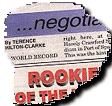

Our biggest match ever
By Terence
Hilton Clarke
(c)copyright
![]()
WHILE this country has seen its share of notable football matches over the past century, no game on local soil, before or since, has been able to capture the level of national attention generated by the World Cup qualifier between Trinidad and Tobago and the U.S.A. on November 19, 1989.
It is probably the greatest football game in our history. The greatest, not because it was a high quality, outstanding contest (which it was not), but as an event.
Two months of anticipation preceded the contest during which the public was galvanized more than ever in support of the national team. Citizens obeyed the request to wear red during the weekend of the match and, it seemed that whoever was not at the National Stadium that afternoon was watching the game on television.
Trinidad and Tobago, unlike some of the more established foot balling countries, had never staged an international game approaching this level of importance. None of the previous World Cup qualifying matches held at home had the status of being the final obstacle to a place in the worldís greatest single-sport event.
But, it is this inexperience that may have been a crucial factor in the negative fall-out that occurred, both on and off the field. Certain things were poorly handled. For instance, it was a notoriously flagrant mistake to have the team remain at Forest Reserve up to the day of the game. Going to a church service, and then having to plod 78 km along crowded roads and highways was both physically and mentally draining. The American team, by contrast, was based right in Port of Spain at the Trinidad Hilton, just 15-20 minutes away from the National Stadium. While one could understand the need to have kept the local squad in a secluded locale such as Forest Reserve, logic should have prevailed when it mattered most. Why the Trinidad and Tobago team could not have spent the night before the game in Port of Spain (maybe even in comfortable hotel like the Americans) is a question that still hasnít been answered.
Indeed, Trinidad and Tobago appeared listless during the first half of the game, during which the United States scored what turned out to be the winning goal. The home team
did display a little more aggression during the second period, but it wasnít enough to break down the shield thrown up by what was, at that time, a defensive American side.More questions arise concerning the safety of the spectators. While the National Stadium has been designed to hold 25,000 spectators, it seems that there were as much as 35,000 people in the arena. Seven months after the Hillsborough disaster in England, this should not have been allowed. Why were so many people put in danger? Couldnít there have been a crush of human bodies? What about structural collapse? The fact remains that only 25,000 official tickets should have been printed and that these should have gone on sale soon after this country's penultimate qualifier against Guatemala on September 1. That way, the tickets most likely would have been sold out weeks in advance: thus preventing the sight of more than 3,000 people being turned away from an overcrowded venue. Instead, for the next five years, the TTFA would be the primary focus of the Seemungal Commission of Inquiry into the alleged overselling of tickets.
Another significant characteristic of the whole atmosphere surrounding the match was the lack of critical analysis regarding the teamís chances. No one in the mainstream press considered the fact that Trinidad and Tobago could lose this game. At the time, few had the perspective to realize that our progress had more to do with pride and determination than with possessing a technically gifted side. But, rather than advise caution, some journalists got carried away by the increasing momentum and made open predictions of victory.
While naiveté and a lack of precedent may have been responsible for the above, a degree of innocence played a part in the surreal scenes which greeted some foreign observers. Instead of bloodthirsty, raucous crowds, what the U.S.A. team encountered was a sea of light-hearted, crimson clad people: non threatening, festive and not prone to intimidation of visiting teams.
The downside, of course, was the fact that the fans did not get as involved in the game as they should have - particularly when Trinidad and Tobago was struggling. So caught up were people in the carnival side-show that many failed to pay much attention to what was happening on the field of play and, as such, didnít start rallying behind their team until it was too late.
| More
Sports with other sports articles divided in categories
|




